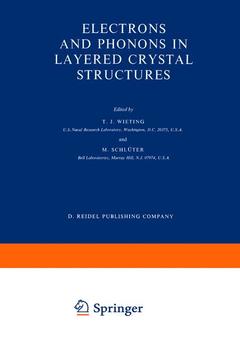Electrons and Phonons in Layered Crystal Structures, Softcover reprint of the original 1st ed. 1979 Physics and Chemistry of Materials with A Series, Vol. 3
Langue : Anglais
Coordonnateurs : Wieting T.J., Schlüter M.

This volume is devoted to the electron and phonon energy states of inorganic layered crystals. The distinctive feature of these low-dimensional materials is their easy mechanical cleavage along planes parallel to the layers. This feature implies that the chemical binding within each layer is much stronger than the binding between layers and that some, but not necessarily all, physical properties of layered crystals have two-dimensional character. In Wyckoff's Crystal Structures, SiC and related com pounds are regarded as layered structures, because their atomic layers are alternately stacked according to the requirements of cubic and hexagonal close-packing. How ever, the uniform (tetrahedral) coordination of the atoms in these compounds excludes the kind of structural anisotropy that is fundamental to the materials dis cussed in this volume. An individual layer of a layered crystal may be composed of either a single sheet of atoms, as in graphite, or a set of up to five atomic sheets, as in Bi2 Te3' A layer may also have more complicated arrangements of the atoms, as we find for example in Sb S . But the unique feature common to all these materials is 2 3 the structural anisotropy, which directly affects their electronic and vibrational properties. The nature of the weak interlayer coupling is not very well understood, despite the frequent attribution of the coupling in the literature to van der Waals forces. Two main facts, however, have emerged from all studies.
I: Electrons.- A Symmetry Considerations.- 1. Group Theoretical Basis.- 1.1. Symmetry of the Schrödinger Equation.- 1.2. Group Representations.- 1.3. Crystal Point and Space Groups.- 1.3.1. Symmorphic Space Groups.- 1.3.2. The Symmorphic Crystal Space Group D3d3.- 1.3.3. Non-Symmorphic Space Groups.- 1.3.4. The Non-Symmorphic Space Group D6h4.- 1.4. Double Groups and Time Reversal Symmetry.- 2. Symmetrized Basis Functions.- 2.1. Use of a Symmetrized Basis.- 2.2. Symmetry of Plane Waves.- 2.3. Group Projection Operators.- 2.4. Example for Symmetrized Plane Waves: Non-Symmorphic Space Group D6h4.- 3. Symmetry Classification of Layer Compounds.- 3.1. Structural Aspects.- 3.2. Group Analysis of Some Layer Compounds.- 3.3. Description of Eight Space Groups of Layer Compounds.- References.- B Methods Used for Calculating Band Structures of Layered Materials.- 1. The Tight-Binding Method (LCAO).- 1.1. Original Formulation of the Tight-Binding Method.- 1.2. The Bromley-Murray Scheme.- 1.3. The Slater-Koster Interpolation Scheme.- 2. The Augmented-Plane-Wave Method (APW).- 2.1. Basic Concepts of the Augmented-Plane-Wave Method.- 2.2. Construction of the Crystal Potential.- 2.3. Calculation of the Energy Eigenvalues.- 2.4. Comments on Computational Details.- 3. The Empirical Pseudopotential Method (EPM).- 3.1. General Considerations of the Pseudopotential Method.- 3.2. The Local Empirical Pseudopotential Method.- 3.3. The Non-Local Empirical Pseudopotential Method.- 3.4. Comments on Fitting Procedures.- 4. The Green’s Function Method (KKR).- 4.1. Variational Procedure for Simple Structures.- 4.2. Generalization to Complex Crystals.- 4.3. Calculation of Structure Factors.- 5. The Method of Linear Combination of Muffin-Tin Orbitals (LCMTO).- 5.1. Mathematical Formulation of Muffin-Tin Orbitals.- 5.2. Variational Scheme Using a Linear Combination of Muffin-Tin Orbitals.- 5.3. Comments on Practical Calculations.- 6. The Layer Transfer-Matrix Method (LTM).- 6.1. Derivation of an Eigenvalue Equation.- 6.2. Calculation of the Transfer Matrix Q.- 6.3. Formulation of the Structure Factors.- 6.4. Mathematical Details.- 7. The Orthogonalized Plane Wave Method (OPW).- 7.1. General Formulation of the OPW Method.- 7.2. Self-Consistent OPW Calculations.- 7.3. Combined OPW-Tight Binding Calculations.- 8. Conclusions.- References.- C Electronic Structure of Some Layer Compounds.- 1. Transition Metal Layer Compounds.- 1.1. Compounds with Octahedral Arrangement of the Cations.- 1.1.1. The Group IVB Transition Metal Chalcogenides.- 1.1.2. The Group VB Transition Metal Dichalcogenide TaS2.- 1.2. Compounds with Trigonal Prismatic Arrangement of the Cations.- 1.2.1. The Group VB Transition Metal Dichalcogenides.- 1.2.2. The Group VIB Transition Metal Dichalcogenides.- 2. Non-Transition Metal Layer Compounds.- 2.1. Compounds with Octahedral Arrangement of the Cations.- 2.1.1. The Tin Dichalcogenides SnS2 and SnSe2.- 2.1.2. The Five-Layer Compound Bi2Te3.- 2.1.3. Lead Iodide PbI2.- 2.1.4. Bismuth Iodide BiI3.- 2.2. Compounds with Trigonal Prismatic Arrangement of the Cations.- 2.2.1. The Gallium Chalcogenides.- 2.3. Hexagonal Network Structures.- 2.3.1. Graphite.- 2.3.2. Boron Nitride.- References.- Acknowledgment.- List of Symbols — Chapter A.- List of Symbols — Chapter B.- List of Symbols — Chapter C.- II: Phonons.- Infrared and Raman Investigations of Long-Wavelength Phonons in Layered Materials.- 1. Introduction.- 2. Structures and Symmetry.- 2.1. Families of Layered Materials.- 2.1.1. GaSe.- 2.1.2. MoS2.- 2.1.3. CdI2.- 2.1.4. Graphite.- 2.1.5. As2S3.- 2.1.6. Sb2S3.- 2.1.7. Bi2Te3.- 2.2. Group Theory and the Correlation Method.- 2.3. Correlation Diagrams.- 2.3.1. ?-GaS.- 2.3.2. ?-GaSe.- 2.3.3. ?-GaSe.- 2.3.4. 3R- and 3T-MoS2.- 2.3.5. 2H-CdI2.- 2.3.6. 4H-CdI2.- 2.3.7. Graphite.- 2.3.8. As2S3.- 2.3.9. Sb2S3.- 2.3.10. Bi2Te3.- 3. Infrared Absorption and Raman Scattering.- 3.1. Selection Rules for Infrared Absorption.- 3.2. Analysis of Infrared Spectra.- 3.3. Effective Charge.- 3.4. Experimental Configurations in Raman Scattering.- 3.5. Raman Selection Rules and Scattered Light Intensity.- 4. Normal Vibrations in Layered Materials.- 4.1. General Properties.- 4.2. Linear-Chain Model.- 5. Experimental Investigations.- 5.1. GaSe Family.- 5.2. MoS2 Family.- 5.3. CdI2 Family.- 5.4. Graphite.- 5.5. As2S3, Sb2S3, and Bi2Te3 Families.- 5.6. Chemical Bonding.- Acknowledgments.- List of Symbols.- References.- Neutron Scattering and Lattice Dynamics of Materials with Layered Structures.- 1. Lattice Dynamics and Inelastic Neutron Scattering.- 1.1. Lattice Dynamics in the Harmonic Approximation.- 1.2. Model of Lattice Dynamics.- 1.3. Inelastic Scattering of Neutrons.- 2. Atomic Vibrations in Layered Compounds.- 3. Neutron Scattering Experiments on Layered Compounds.- 3.1. Introduction.- 3.2. Graphite.- 3.3. Transition Metal Dichalcogenides (TX2).- 3.3.1. MoS2 (2H).- 3.3.2. NbSe2.- 3.3.3. TiSe2.- 3.4. GaSe.- 3.5. PbI2.- 3.6. Iodine.- Acknowledgment.- List of Symbols.- References.- Index of Layered Materials.
Date de parution : 10-2011
Ouvrage de 486 p.
17x24.4 cm
Disponible chez l'éditeur (délai d'approvisionnement : 15 jours).
Prix indicatif 52,74 €
Ajouter au panierThème d’Electrons and Phonons in Layered Crystal Structures :
Mots-clés :
Absorption; Atom; Pseudopotential; Sorption; bonding; crystal structure; metals; structure
© 2024 LAVOISIER S.A.S.


